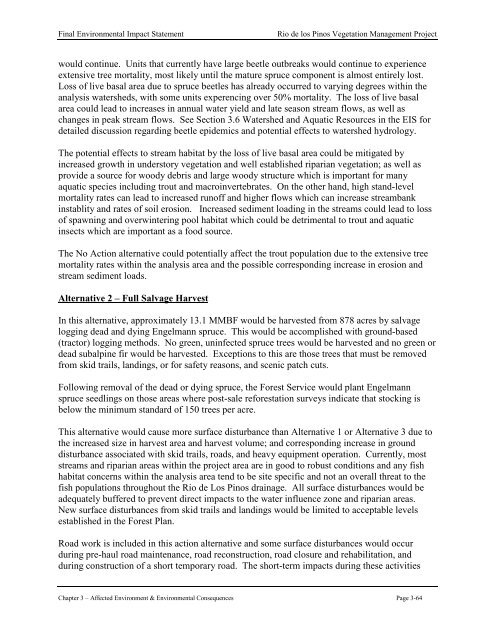Final Environmental Impact Statement Rio de los Pinos Vegetation ...
Final Environmental Impact Statement Rio de los Pinos Vegetation ...
Final Environmental Impact Statement Rio de los Pinos Vegetation ...
You also want an ePaper? Increase the reach of your titles
YUMPU automatically turns print PDFs into web optimized ePapers that Google loves.
<strong>Final</strong> <strong>Environmental</strong> <strong>Impact</strong> <strong>Statement</strong> <strong>Rio</strong> <strong>de</strong> <strong>los</strong> <strong>Pinos</strong> <strong>Vegetation</strong> Management Project<br />
would continue. Units that currently have large beetle outbreaks would continue to experience<br />
extensive tree mortality, most likely until the mature spruce component is almost entirely <strong>los</strong>t.<br />
Loss of live basal area due to spruce beetles has already occurred to varying <strong>de</strong>grees within the<br />
analysis watersheds, with some units experencing over 50% mortality. The <strong>los</strong>s of live basal<br />
area could lead to increases in annual water yield and late season stream flows, as well as<br />
changes in peak stream flows. See Section 3.6 Watershed and Aquatic Resources in the EIS for<br />
<strong>de</strong>tailed discussion regarding beetle epi<strong>de</strong>mics and potential effects to watershed hydrology.<br />
The potential effects to stream habitat by the <strong>los</strong>s of live basal area could be mitigated by<br />
increased growth in un<strong>de</strong>rstory vegetation and well established riparian vegetation; as well as<br />
provi<strong>de</strong> a source for woody <strong>de</strong>bris and large woody structure which is important for many<br />
aquatic species including trout and macroinvertebrates. On the other hand, high stand-level<br />
mortality rates can lead to increased runoff and higher flows which can increase streambank<br />
instablity and rates of soil erosion. Increased sediment loading in the streams could lead to <strong>los</strong>s<br />
of spawning and overwintering pool habitat which could be <strong>de</strong>trimental to trout and aquatic<br />
insects which are important as a food source.<br />
The No Action alternative could potentially affect the trout population due to the extensive tree<br />
mortality rates within the analysis area and the possible corresponding increase in erosion and<br />
stream sediment loads.<br />
Alternative 2 – Full Salvage Harvest<br />
In this alternative, approximately 13.1 MMBF would be harvested from 878 acres by salvage<br />
logging <strong>de</strong>ad and dying Engelmann spruce. This would be accomplished with ground-based<br />
(tractor) logging methods. No green, uninfected spruce trees would be harvested and no green or<br />
<strong>de</strong>ad subalpine fir would be harvested. Exceptions to this are those trees that must be removed<br />
from skid trails, landings, or for safety reasons, and scenic patch cuts.<br />
Following removal of the <strong>de</strong>ad or dying spruce, the Forest Service would plant Engelmann<br />
spruce seedlings on those areas where post-sale reforestation surveys indicate that stocking is<br />
below the minimum standard of 150 trees per acre.<br />
This alternative would cause more surface disturbance than Alternative 1 or Alternative 3 due to<br />
the increased size in harvest area and harvest volume; and corresponding increase in ground<br />
disturbance associated with skid trails, roads, and heavy equipment operation. Currently, most<br />
streams and riparian areas within the project area are in good to robust conditions and any fish<br />
habitat concerns within the analysis area tend to be site specific and not an overall threat to the<br />
fish populations throughout the <strong>Rio</strong> <strong>de</strong> Los <strong>Pinos</strong> drainage. All surface disturbances would be<br />
a<strong>de</strong>quately buffered to prevent direct impacts to the water influence zone and riparian areas.<br />
New surface disturbances from skid trails and landings would be limited to acceptable levels<br />
established in the Forest Plan.<br />
Road work is inclu<strong>de</strong>d in this action alternative and some surface disturbances would occur<br />
during pre-haul road maintenance, road reconstruction, road c<strong>los</strong>ure and rehabilitation, and<br />
during construction of a short temporary road. The short-term impacts during these activities<br />
Chapter 3 – Affected Environment & <strong>Environmental</strong> Consequences Page 3-64
















